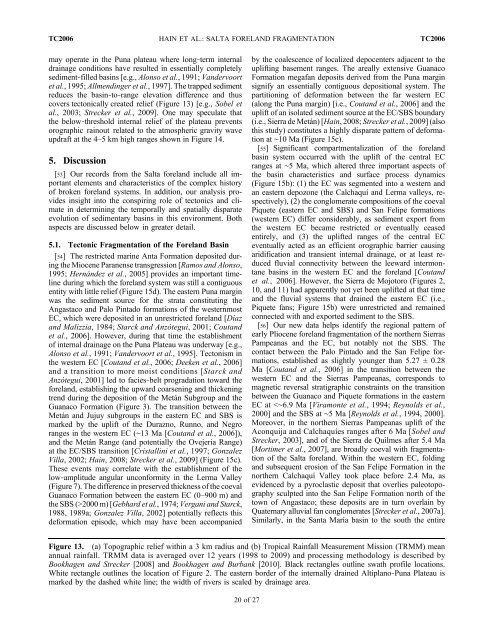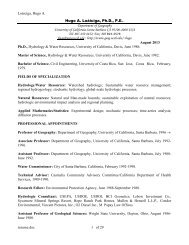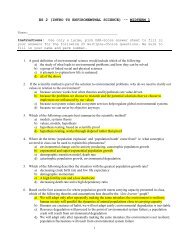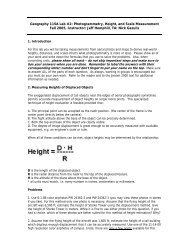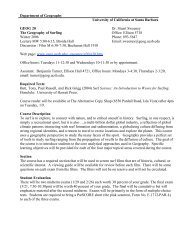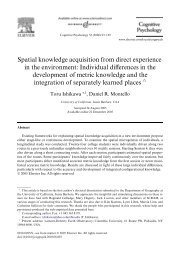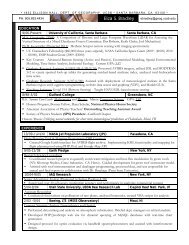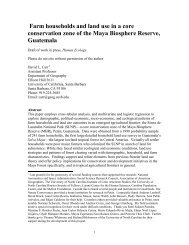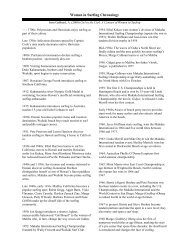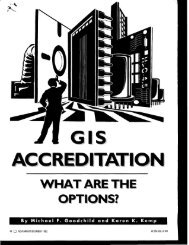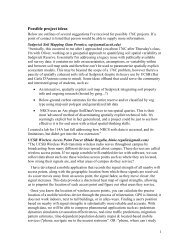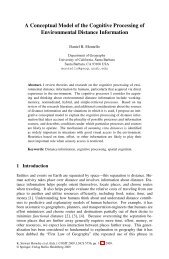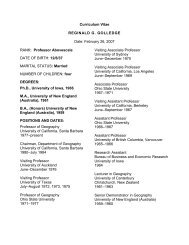Hain, M., Strecker, M.R., Bookhagen, B., Alonso, R.N., Pingel, H. and ...
Hain, M., Strecker, M.R., Bookhagen, B., Alonso, R.N., Pingel, H. and ...
Hain, M., Strecker, M.R., Bookhagen, B., Alonso, R.N., Pingel, H. and ...
You also want an ePaper? Increase the reach of your titles
YUMPU automatically turns print PDFs into web optimized ePapers that Google loves.
TC2006<br />
HAIN ET AL.: SALTA FORELAND FRAGMENTATION<br />
TC2006<br />
may operate in the Puna plateau where long‐term internal<br />
drainage conditions have resulted in essentially completely<br />
sediment‐filled basins [e.g., <strong>Alonso</strong> et al., 1991; V<strong>and</strong>ervoort<br />
et al., 1995; Allmendinger et al., 1997]. The trapped sediment<br />
reduces the basin‐to‐range elevation difference <strong>and</strong> thus<br />
covers tectonically created relief (Figure 13) [e.g., Sobel et<br />
al., 2003; <strong>Strecker</strong> et al., 2009]. One may speculate that<br />
the below‐threshold internal relief of the plateau prevents<br />
orographic rainout related to the atmospheric gravity wave<br />
updraft at the 4–5 km high ranges shown in Figure 14.<br />
5. Discussion<br />
[53] Our records from the Salta forel<strong>and</strong> include all important<br />
elements <strong>and</strong> characteristics of the complex history<br />
of broken forel<strong>and</strong> systems. In addition, our analysis provides<br />
insight into the conspiring role of tectonics <strong>and</strong> climate<br />
in determining the temporally <strong>and</strong> spatially disparate<br />
evolution of sedimentary basins in this environment. Both<br />
aspects are discussed below in greater detail.<br />
5.1. Tectonic Fragmentation of the Forel<strong>and</strong> Basin<br />
[54] The restricted marine Anta Formation deposited during<br />
the Miocene Paranense transgression [Ramos <strong>and</strong> <strong>Alonso</strong>,<br />
1995; Hernández et al., 2005] provides an important timeline<br />
during which the forel<strong>and</strong> system was still a contiguous<br />
entity with little relief (Figure 15d). The eastern Puna margin<br />
was the sediment source for the strata constituting the<br />
Angastaco <strong>and</strong> Palo Pintado formations of the westernmost<br />
EC, which were deposited in an unrestricted forel<strong>and</strong> [Díaz<br />
<strong>and</strong> Malizzia, 1984; Starck <strong>and</strong> Anzótegui, 2001; Cout<strong>and</strong><br />
et al., 2006]. However, during that time the establishment<br />
of internal drainage on the Puna Plateau was underway [e.g.,<br />
<strong>Alonso</strong> et al., 1991; V<strong>and</strong>ervoort et al., 1995]. Tectonism in<br />
the western EC [Cout<strong>and</strong> et al., 2006; Deeken et al., 2006]<br />
<strong>and</strong> a transition to more moist conditions [Starck <strong>and</strong><br />
Anzótegui, 2001] led to facies‐belt progradation toward the<br />
forel<strong>and</strong>, establishing the upward coarsening <strong>and</strong> thickening<br />
trend during the deposition of the Metán Subgroup <strong>and</strong> the<br />
Guanaco Formation (Figure 3). The transition between the<br />
Metán <strong>and</strong> Jujuy subgroups in the eastern EC <strong>and</strong> SBS is<br />
marked by the uplift of the Durazno, Runno, <strong>and</strong> Negro<br />
ranges in the western EC (∼13 Ma [Cout<strong>and</strong> et al., 2006]),<br />
<strong>and</strong> the Metán Range (<strong>and</strong> potentially the Ovejeria Range)<br />
at the EC/SBS transition [Cristallini et al., 1997; Gonzalez<br />
Villa, 2002; <strong>Hain</strong>, 2008; <strong>Strecker</strong> et al., 2009] (Figure 15c).<br />
These events may correlate with the establishment of the<br />
low‐amplitude angular unconformity in the Lerma Valley<br />
(Figure 7). The difference in preserved thickness of the coeval<br />
Guanaco Formation between the eastern EC (0–900 m) <strong>and</strong><br />
the SBS (>2000 m) [Gebhard et al.,1974;Vergani <strong>and</strong> Starck,<br />
1988, 1989a; Gonzalez Villa, 2002] potentially reflects this<br />
deformation episode, which may have been accompanied<br />
by the coalescence of localized depocenters adjacent to the<br />
uplifting basement ranges. The areally extensive Guanaco<br />
Formation megafan deposits derived from the Puna margin<br />
signify an essentially contiguous depositional system. The<br />
partitioning of deformation between the far western EC<br />
(along the Puna margin) [i.e., Cout<strong>and</strong> et al., 2006] <strong>and</strong> the<br />
uplift of an isolated sediment source at the EC/SBS boundary<br />
(i.e., Sierra de Metán) [<strong>Hain</strong>, 2008; <strong>Strecker</strong> et al., 2009] (also<br />
this study) constitutes a highly disparate pattern of deformation<br />
at ∼10 Ma (Figure 15c).<br />
[55] Significant compartmentalization of the forel<strong>and</strong><br />
basin system occurred with the uplift of the central EC<br />
ranges at ∼5 Ma, which altered three important aspects of<br />
the basin characteristics <strong>and</strong> surface process dynamics<br />
(Figure 15b): (1) the EC was segmented into a western <strong>and</strong><br />
an eastern depozone (the Calchaquí <strong>and</strong> Lerma valleys, respectively),<br />
(2) the conglomerate compositions of the coeval<br />
Piquete (eastern EC <strong>and</strong> SBS) <strong>and</strong> San Felipe formations<br />
(western EC) differ considerably, as sediment export from<br />
the western EC became restricted or eventually ceased<br />
entirely, <strong>and</strong> (3) the uplifted ranges of the central EC<br />
eventually acted as an efficient orographic barrier causing<br />
aridification <strong>and</strong> transient internal drainage, or at least reduced<br />
fluvial connectivity between the leeward intermontane<br />
basins in the western EC <strong>and</strong> the forel<strong>and</strong> [Cout<strong>and</strong><br />
et al., 2006]. However, the Sierra de Mojotoro (Figures 2,<br />
10, <strong>and</strong> 11) had apparently not yet been uplifted at that time<br />
<strong>and</strong> the fluvial systems that drained the eastern EC (i.e.,<br />
Piquete fans; Figure 15b) were unrestricted <strong>and</strong> remained<br />
connected with <strong>and</strong> exported sediment to the SBS.<br />
[56] Our new data helps identify the regional pattern of<br />
early Pliocene forel<strong>and</strong> fragmentation of the northern Sierras<br />
Pampeanas <strong>and</strong> the EC, but notably not the SBS. The<br />
contact between the Palo Pintado <strong>and</strong> the San Felipe formations,<br />
established as slightly younger than 5.27 ± 0.28<br />
Ma [Cout<strong>and</strong> et al., 2006] in the transition between the<br />
western EC <strong>and</strong> the Sierras Pampeanas, corresponds to<br />
magnetic reversal stratigraphic constraints on the transition<br />
between the Guanaco <strong>and</strong> Piquete formations in the eastern<br />
EC at


